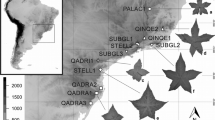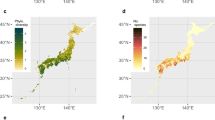Abstract
Statistical population analyses have been carried out on so-calledOphrys “arachnitiformis”, partly sympatricO. sphecodes s. l. as well as on other species ofOphrys (O. holosericea, O. exaltata, O. apulica, O. cornuta, O. biscutella, O. bertolonii, O. bertoloniiformis.). Altogether 63 populations with 521 individuals were studied in regard to 54 morphological parameters. — It can be shown thatO. arachnitiformis is an extremely heterogeneous assemblage which includes taxa of most diverse origin, different degrees of stability and nomenclatorial rank. Only common trait is their very diverse relationships withO. specodes s.l.—The basionymO. arachnitiformis Gren. & Phil. refers to a colour variant ofO. sphecodes Mill. subsp.sphecodes only, and is not applicable to other segments of the assemblage.
A late flowering, morphologically and biologically well isolated group of populations from southern France without any perceptible hybrid influence is established as a new species:Ophrys splendida Gölz & Reinhard. Populations from north and central Italy with distinct characters but hybrid influences fromO. holosericea/O. exaltata are calledO. tyrrhena Gölz & Reinhard.O. morisii, an endemic to Sardinia, represents an independent species of still obscure evolution. The hybrid interpretation ofO. catalaunica is statistically corroborated, but somewhat modified. For the remaining segments ofO. “arachnitiformis” investigated (from Castilia, Dalmatia, and the Monte Gargano) no formal taxonomic proposals are made, but some suggestions about their genesis are possible.
Similar content being viewed by others
Literaturverzeichnis
Barla, J.-B., 1868: Flore illustrée de Nice et des Alpes-Maritimes. Iconographie des Orchidées. — Nice: Caisson et Mignon.
Ciferri, R., Giacomini, V., 1950: Nomenclator Florae ItalicaeI. — Pavia: Ticini.
Danesch, O., Danesch, E., 1972: Orchideen Europas,Ophrys-Hybriden. — Bern-Stuttgart: Hallwag.
, 1975: Hybriden und hybridogene Sippen ausOphrys bertolonii undO. atrata (Orchidaceae). — Pl. Syst. Evol.124, 79–123.
Fuchs, A., 1917: LechtalerOphrys (Fortsetzung). — Ber. Bayer. Bot. Ges.16, 76–86.
Gölz, P., 1976: Statistische Untersuchungen an europäischen Orchideen (II). — Jahresber. Nat. wiss. Ver. Wuppertal29, 118–130.
, 1973: Biostatistische Untersuchungen an europäischen Orchideen. — Ber. Schweiz. Bot. Ges.83, 93–105.
, 1975: Biostatische Untersuchungen überOphrys bertoloniiformis O. & E. Danesch. — Ber. Schweiz. Bot. Ges.85, 31–56.
, 1979: Biostatistische Untersuchungen überOphrys bertoloniiformis O. & E. Danesch (2. Teil). — Ber. Schweiz. Bot. Ges.89, 63–79.
Grenier, Ch., 1860: Recherches sur quelques Orchidées des environs de Toulon. — Mém. Soc. Emul. Doubs, Sér. III,4, 399 (1859, erschienen 1860).
- 1869: Flore de la Chaîne Jurassique. Paris, Besançon.
Keller, G., Soó, R., 1930–1940: Kritische Monographie der Orchideen Europas und des Mittelmeergebietes. Repert. Spec. Nov., Sonderbeiheft A 2. Berlin-Dahlem.
Kullenberg, B., 1978: Remarks on the origin of the extracts ofOphrys (Orchidaceae) labella used by. Mr.Jan Tengö in his studies on scent-induced behaviour inAndrena males. — Appendix inTengö, J.: Odour released behaviour inAndrena male bees (Apoidea, Hymenoptera). — Ecological Station of Uppsala University. Färjestaden, Sweden.
, 1976:Hymenoptera Aculeata Males as Polinators ofOphrys Orchids. — Zoologica Scripta5, 13–23. Uppsala.
Martelli, U., 1896: Monocotyledones Sardoae1. — Firenze: Niccolai.
Nelson, E., 1962: Gestaltwandel und Artbildung, erörtert am Beispiel der Orchidaceen Europas und der Mittelmeerländer, insbesondere der GattungOphrys. — Chernex-Montreux: E. Nelson.
Priesner, E., 1973: Reaktionen von Riechrezeptoren männlicher Solitärbienen (Hymenoptera, Apoidea) auf Inhaltsstoffe vonOphrys-Blüten. — Zoon Suppl.1, 43–54, 1 Tafel. Uppsala.
Reichenbach fil.,H. G., 1851: Die Orchideen der deutschen Flora, aus Deutschlands Flora13. Leipzig: F. Hofmeister.
Reinhard, H. R., 1972: Über Ursprung und Variabilität vonOphrys arachnitiformis Gren. & Phil. — Jahresber. Naturwiss. Ver. Wuppertal25, 140–151.
Ruppert, J., 1933: Beiträge zur Kenntnis italienischerOrchidaceen. — Feddes Rep.31, 369–388.
Schrenk, W. J., 1972: „Ophrys arachnitiformis Gren. & Phil.“ — genetische Überlegungen und ihre Konsequenzen. — Jahresber. Naturwiss. Ver. Wuppertal25, 152–156.
Soó, R. v., 1927/1928:Orchideae novae europeae et mediterraneae. — Feddes Rep.24, 25–37.
Sundermann, H., 1972:Ophrys arachnitiformis — eine Art? — Jahresber. Naturwiss. Ver. Wuppertal25, 142–145.
Teschner, W., 1972:Ophrys arachnitiformis Gren. & Phil.: Erstnachweis für Jugoslawien. — Jahresber. Naturwiss. Ver. Wuppertal25, 157–158.
Author information
Authors and Affiliations
Rights and permissions
About this article
Cite this article
Gölz, P., Reinhard, H.R. Populationsstatistische Analysen bestätigen die Heterogeneität vonOphrys „arachnitiformis“ (Orchidaceae). Pl Syst Evol 136, 7–39 (1980). https://doi.org/10.1007/BF00985309
Received:
Issue Date:
DOI: https://doi.org/10.1007/BF00985309




